Psychometric Properties of the Polish Version of Task and Ego Orientation in Sport Questionnaire (TEOSQ)
Abstract
1. Introduction
2. Method
2.1. Participants
2.2. Measurement Tools
2.3. Statistical Analysis
3. Results
3.1. Analysis of Internal Consistency and the Item-Rest Correlations
3.2. Reliability Analysis by Test-Retest
3.3. Analysis of the Item Reliability Based on IRT Model
3.4. Analysis of the Factor Structure of TEOSQ
3.5. Relationships between TEOSQ Subscales and SMS-28 Components
3.6. The Relationship between Sport Type, Level of Participation, Gender and TEOSQ Subscales
4. Discussion
5. Conclusions
Author Contributions
Funding
Conflicts of Interest
References
- Nicholls, J.G. Achievement motivation: Conceptions of ability, subjective experience, task choice, and performance. Psychol. Rev. 1984, 91, 328–346. [Google Scholar] [CrossRef]
- Nicholls, J.G. The Competitive Ethos and Democratic Education; MD, Harvard University Press: Cambridge, UK, 1989. [Google Scholar]
- Chi, L.; Duda, J.L. Multi-sample confirmatory factor analysis of the task and ego orientation in sport questionnaire. Res. Q. Exercise Sport 1995, 66, 91–98. [Google Scholar] [CrossRef] [PubMed]
- Li, F.; Harmer, P.; Chi, L.; Vongjaturapat, S. Cross-cultural validation of the task and ego orientation in sport questionnaire. J. Sport Exercise Psychol. 1996, 18, 392–407. [Google Scholar] [CrossRef]
- Bortoli, L.; Robazza, C. Italian version of the Task and Ego Orientation in Sport Questionnaire. Perceptual Mot. Skills 2005, 100, 43–50. [Google Scholar] [CrossRef]
- Jaakkola, T.; Ntoumanis, N.; Liukkonen, J. Motivational climate, goal orientation, perceived sport ability, and enjoyment within Finnish junior ice hockey players. Scand. J. Med. Sci. Sport 2016, 26, 109–115. [Google Scholar] [CrossRef] [PubMed]
- Duda, J.L. The relationship between task and ego orientation and the perceived purpose of sport among high school athletes. J. Sport Exercise Psychol. 1989, 11, 318–335. [Google Scholar] [CrossRef]
- Duda, J.L.; Nicholls, J.G. Dimensions of achievement motivation in schoolwork and sport. J. Educ. Psychol. 1992, 84, 290–299. [Google Scholar] [CrossRef]
- Lochbaum, M.; Kazak Çetinkalp, Z.; Graham, K.; Wright, T.; Zazo, R. Task and ego goal orientations in competitive sport: A quantitative review of the literature from 1989 to 2016. Kinesiology 2016, 48, 3–29. [Google Scholar] [CrossRef]
- Clancy, R.B.; Herring, M.P.; Campbell, M.J. Motivation Measures in Sport: A Critical Review and Bibliometric Analysis. Front. Psychol. 2017, 8, 348. [Google Scholar] [CrossRef]
- Li, F.; Hamer, P.; Duncan, T.E.; Duncan, S.C.; Acock, A.; Yamamoto, T. Confirmatory Factor Analysis of the Task and Ego Orientation in Sport Questionnaire with Cross-Validation. Res. Q. Exercise Sport 1998, 69, 276–283. [Google Scholar] [CrossRef]
- Castillo, I.; Tomas, I.; Balaguer, I.; Fonseca, A.M.; Dias, C.; Duda, J.L. The Task and Ego Orientation in Sport Questionnaire: Testing for Measurement Invariance and Latent Mean Differences in Spanish and Portuguese Adolescents. Int. J. Test. 2010, 10, 21–32. [Google Scholar] [CrossRef]
- Kim, B.J.; Gill, D.L. A cross-cultural extension of goal perspective theory to Korean youth sport. J. Sport Exercise Psychol. 1997, 19, 142–155. [Google Scholar] [CrossRef][Green Version]
- López-Walle, J.; Balaguer, I.; Meliá, J.L.; Castillo, I.; Tristán, J. Adaptación a la población mexicana del Cuestionario de Orientación al Ego ya la Tarea en el Deporte (TEOSQ). Revista de Psicología del Deporte 2011, 20, 523–536. [Google Scholar]
- Pelletier, L.G.; Rocchi, M.A.; Vallerand, R.J.; Deci, E.L.; Ryan, R.M. Validation of the revised sport motivation scale (SMS-II). Psychol. Sport Exercise 2013, 14, 329–341. [Google Scholar] [CrossRef]
- Chin, N.; Knoo, S.; Low, W. Self-determination and goal orientation in track and field. J. Hum. Kinet. 2012, 33, 151–161. [Google Scholar] [CrossRef] [PubMed]
- Wang, C.K.J.; Biddle, S. Intrinsic motivation towards sports in Singaporean students: The role of sport ability beliefs. J. Health Psychol. 2003, 8, 515–523. [Google Scholar] [CrossRef]
- Doganis, G. Development of a Greek version of the Sport Motivation Scale. Perceptual Mot. Skills 2000, 90, 505–512. [Google Scholar] [CrossRef]
- Ntoumanis, N. A self-determination approach to the understanding of motivation in physical education. Br. J. Educ. Psychol. 2001, 71, 225–242. [Google Scholar] [CrossRef]
- Biddle, S.; Wang, C.J.; Kavussanu, M.; Spray, C. Correlates of achievement goal orientations in physical activity: A systematic review of research. Eur. J. Sport Sci. 2003, 3, 1–20. [Google Scholar] [CrossRef]
- Ntoumanis, N.; Biddle, S. The relationship between competitive anxiety, achievement goals and motivation climates. Res. Quarterly Exercise Sport 1998, 69, 176–187. [Google Scholar] [CrossRef]
- Lameiras, J.; Almeida, P.L.; Garcia-Mas, A. Relationships between cooperation and goal orientation among male professional and semi-professional team athletes. Perceptual Mot. Skills 2014, 119, 851–860. [Google Scholar] [CrossRef] [PubMed]
- Wayment, H.A.; Walters, A.S. Goal orientation and well-being in college athletes: The importance of athletic social connectedness. J. Sports Sci. 2017, 35, 2114–2120. [Google Scholar] [CrossRef] [PubMed]
- Tomczak, M.; Walczak, M. Psychometric properties of the Polish version of Task and Ego Orientations in Sport Questionnaire (TEOSQ). Sport and Exercise Psychology: Human Performance, Well-Being and Health. In Proceedings of the 13th FEPSAC European Congress of Sport Psychology, Madeira, Portugal, 12–17 July 2011; Serpa, S., Teixera, N., Almeida, M.J., Rosado, A., Eds.; Institute of Sport of the Autonomous Region of Madeira: Madeira, Portugal, 2011. [Google Scholar]
- Pelletier, L.G.; Fortier, M.S.; Vallerand, R.J.; Tuson, K.M.; Briere, N.M.; Blais, M.R. Toward a new measure of intrinsic motivation, extrinsic motivation, and amotivation in sports: The Sport Motivation. J. Sport Exercise Psychol. 1995, 17, 35–53. [Google Scholar] [CrossRef]
- Walczak, M.; Tomczak, M. Validation of the Polish version of Sport Motivation Scale (SMS). Effect of gender, level of participation and sport type on intrinsic and extrinsic motives. Trends. Sport Sci. 2019, 26, 187–195. [Google Scholar]
- Ciżkowicz, B. Omega McDonalda jako alternatywa dla alfa Cronbacha w szacowaniu rzetelności testu. Polskie Forum Psychologiczne 2018, 23, 311–329. [Google Scholar]
- Zinbard, R.E.; Revelle, W.; Yovel, I.; Wen, L. Cronbach’s α, Revelle’s β, McDonald’s ωH: Their relations with each other and two alternative conceptualizations of reliability. Psychometrika 2005, 70, 123–133. [Google Scholar] [CrossRef]
- Koch, W.R. Likert scaling using the graded response latent trait model. Appl. Psychol. Meas. 1983, 7, 15–32. [Google Scholar] [CrossRef]
- Rizopoulos, D. ltm: An R package for latent variable modeling and item response theory analyses. J. Stat. Software 2006, 17, 1–25. [Google Scholar] [CrossRef]
- DeMars, C. Item Response Theory; Oxford University Press: Oxford, UK, 2010. [Google Scholar]
- Hu, L.T.; Bentler, P.M. Cutoff criteria for fit indexes in covariance structure analysis: Conventional criteria versus new alternatives. Struct. Equation Model. 1999, 6, 1–55. [Google Scholar] [CrossRef]
- Hooper, D.; Coughlan, J.; Mullen, M.R. Structural equation modelling: Guidelines for determining model fit. Electron. J. Bus. Res. Methods 2008, 6, 53–60. [Google Scholar]
- Bedyńska, S.; Książek, M. Statystyczny drogowskaz 3. In Praktyczny Przewodnik Wykorzystania Modeli Regresji Oraz Równań Strukturalnych; Wydawnictwo Akademickie Sedno: Warszawa, Poland, 2012. [Google Scholar]
- Marsh, H.W.; Hau, K.T.; Wen, Z. In search of golden rules: Comment on hypothesis-testing approaches to setting cutoff values for fit indexes and dangers in overgeneralizing Hu and Bentler’s (1999) findings. Struct. Equation Model. 2004, 11, 320–341. [Google Scholar] [CrossRef]
- Stanisz, A. Przystępny Kurs Statystyki z Zastosowaniem Statistca PL na Przykładach z Medycyny, 1st ed.; Statsoft Polska: Kraków, Poland, 2007. [Google Scholar]
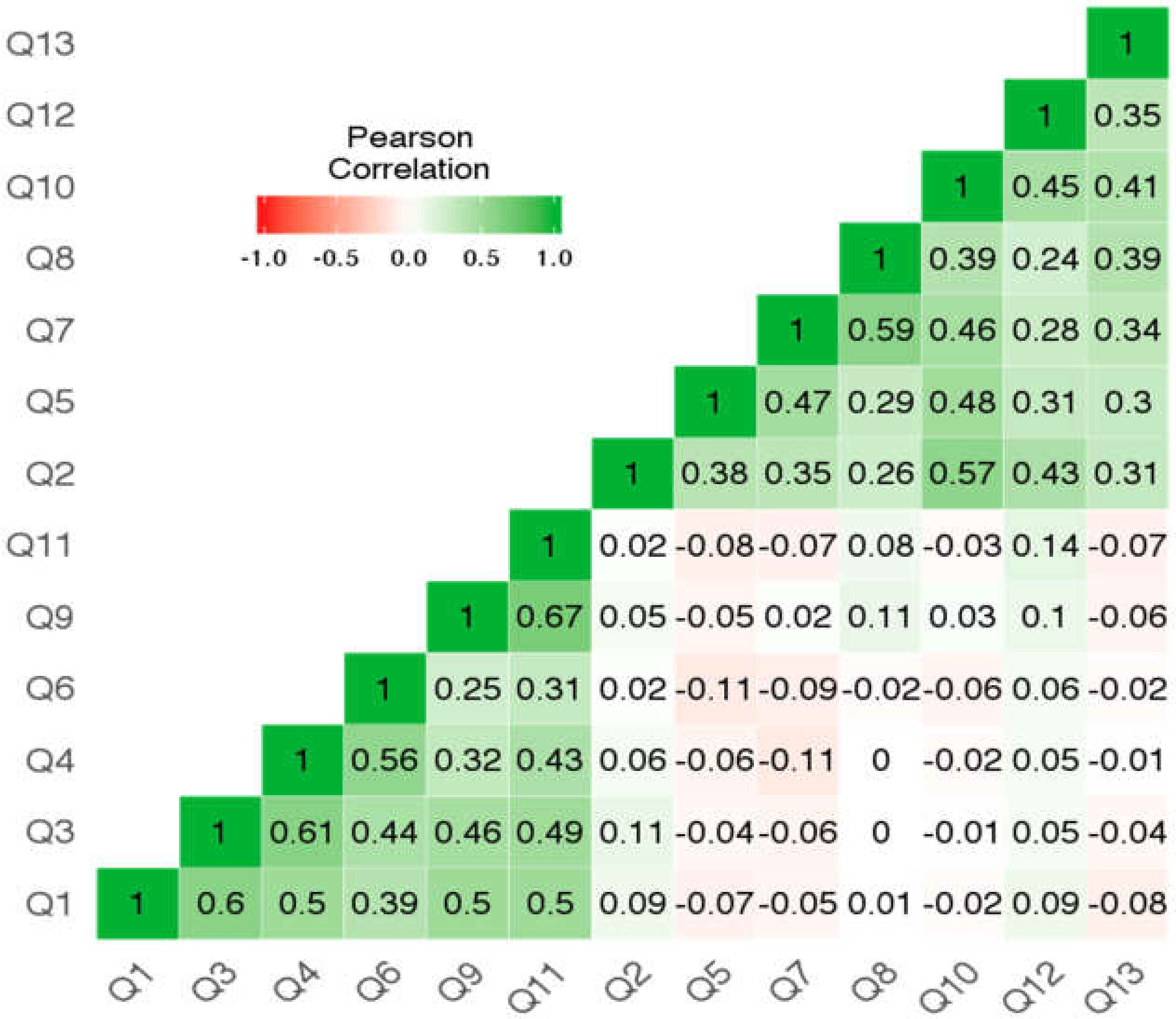
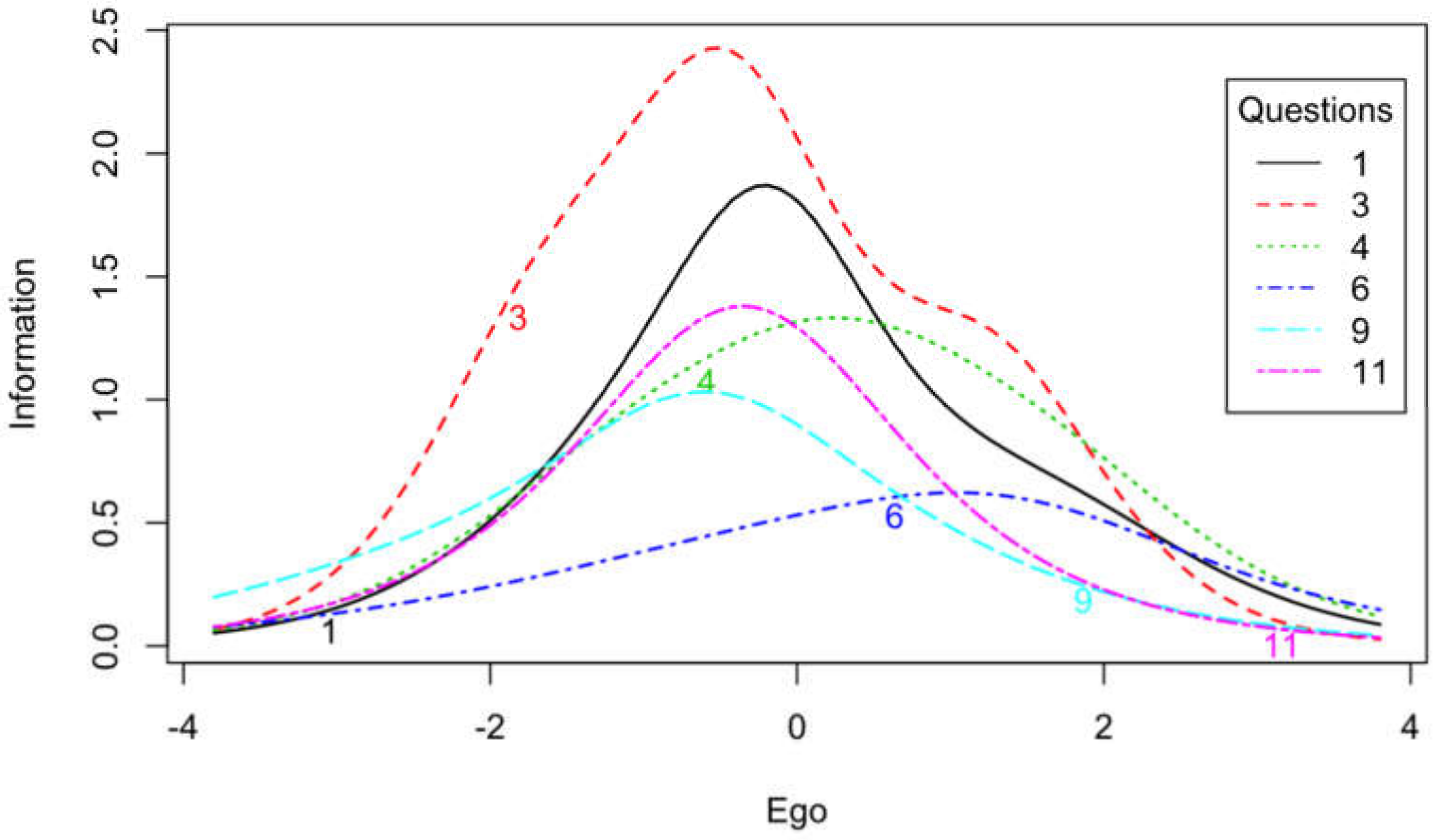
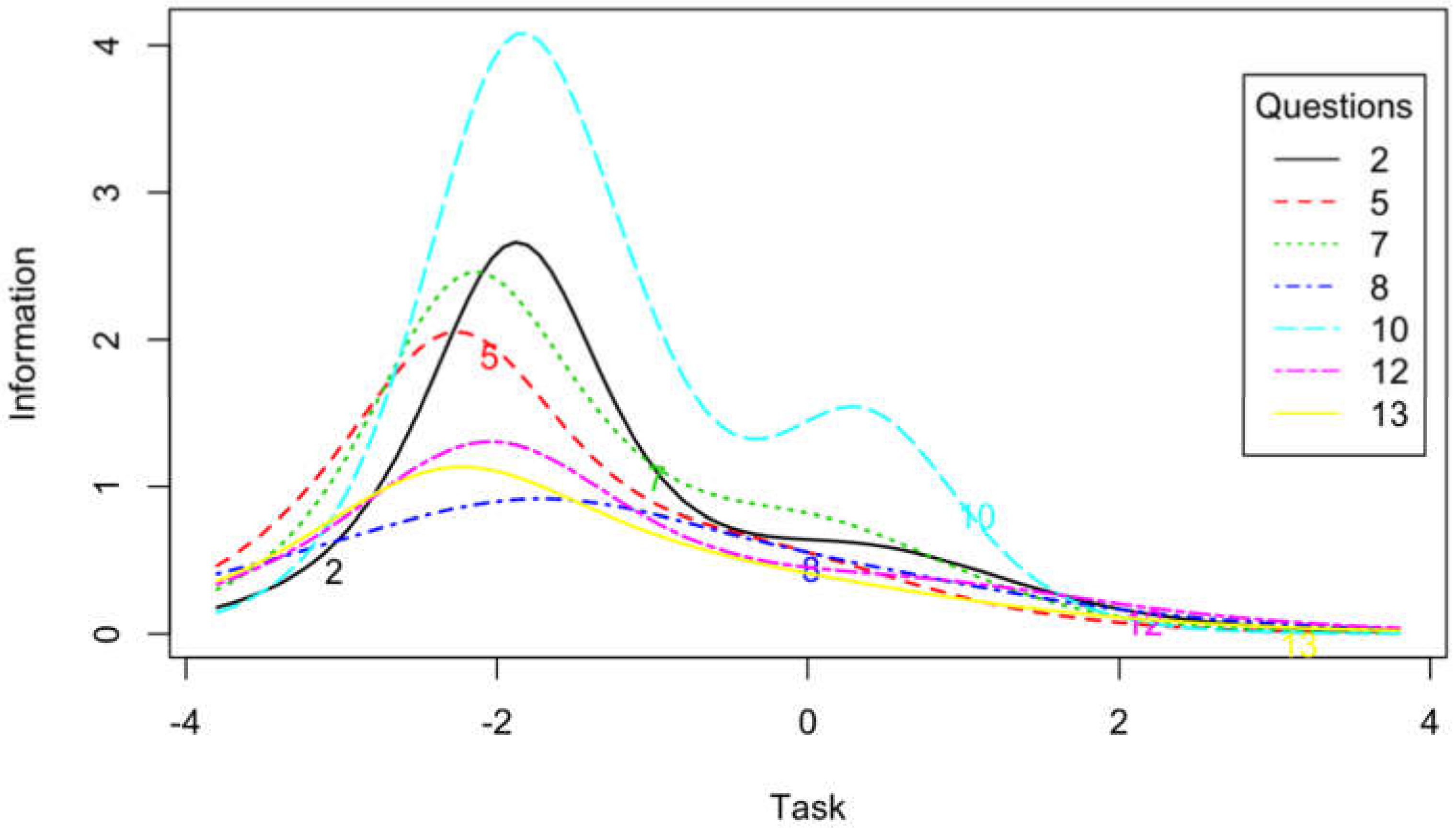
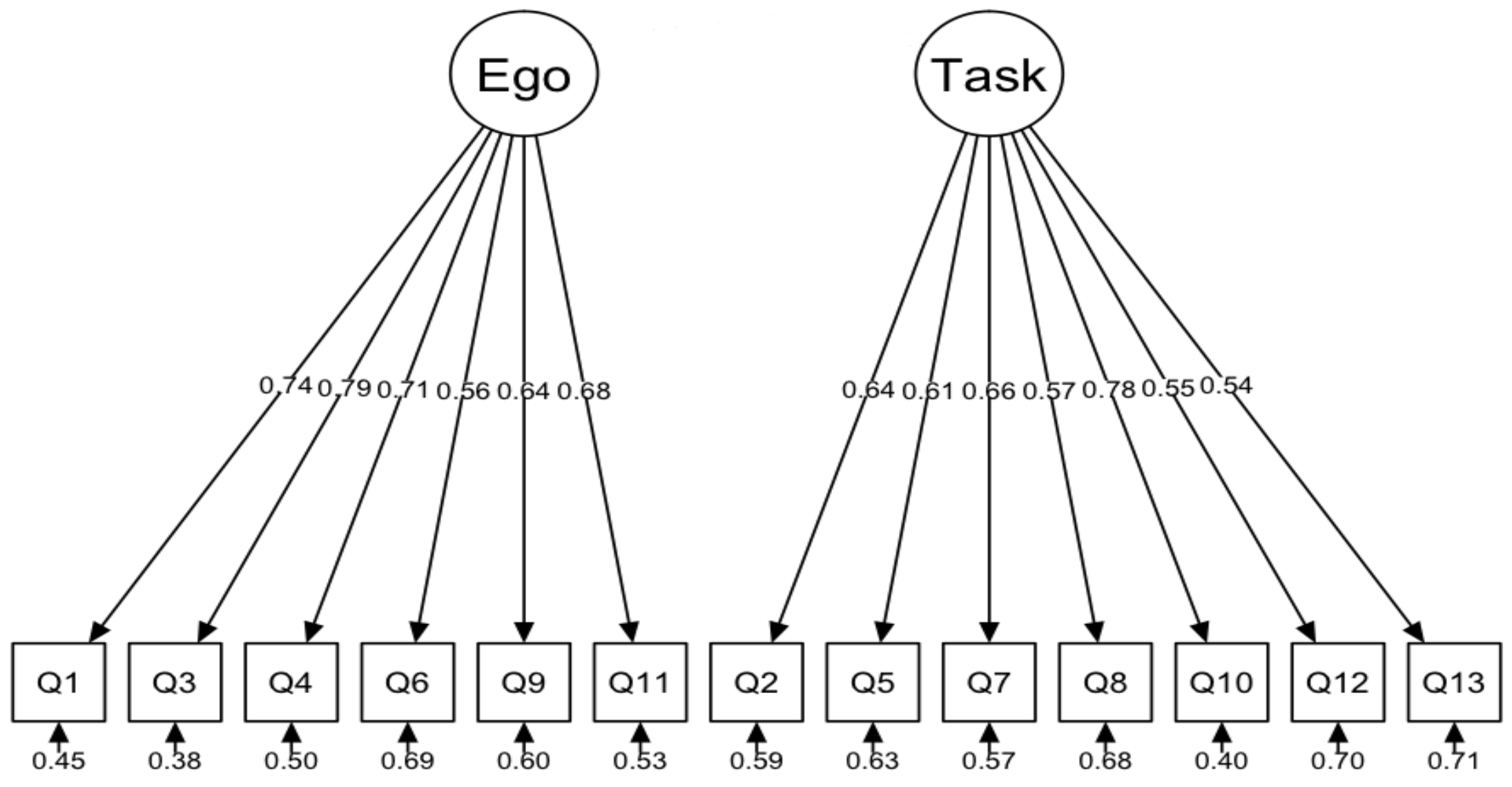

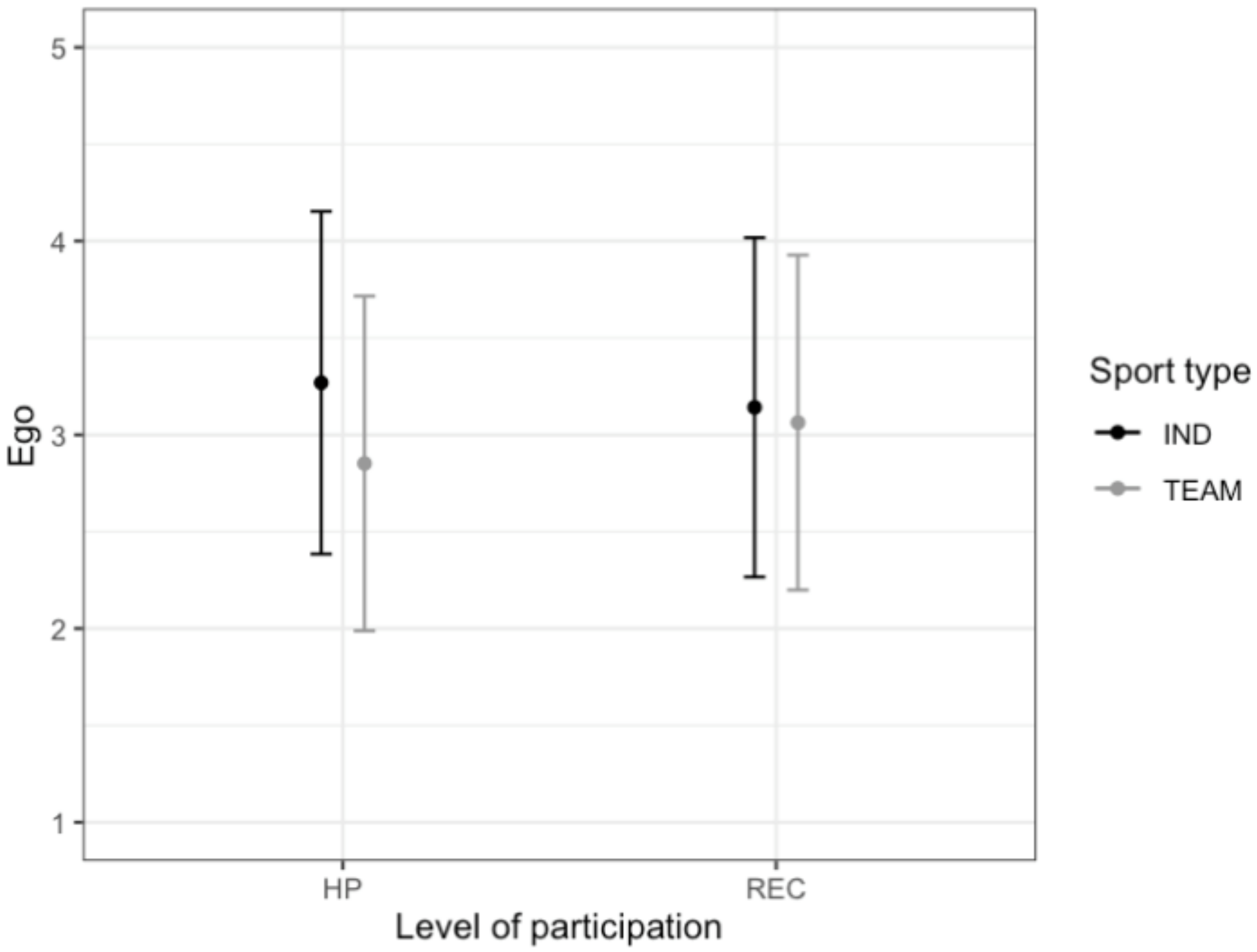

| TEOSQ Items | IRT Information of Ability in Range (−4,4) | |
|---|---|---|
| Raw | Percent | |
| Q1 | 5.59 | 0.99 |
| Q3 | 8.08 | 1.00 |
| Q4 | 5.40 | 0.98 |
| Q6 | 2.81 | 0.92 |
| Q9 | 3.72 | 0.94 |
| Q11 | 4.08 | 0.98 |
| Q2 | 5.74 | 0.98 |
| Q5 | 5.22 | 0.95 |
| Q7 | 6.22 | 0.98 |
| Q8 | 3.70 | 0.89 |
| Q10 | 9.49 | 1.00 |
| Q12 | 4.13 | 0.94 |
| Q13 | 3.59 | 0.93 |
| Variables | Subscales of Sport Motivation Scale | ||||||
|---|---|---|---|---|---|---|---|
| KN | AC | ES | IDF | INT | ER | AMT | |
| EGO | −0.03 | −0.03 | −0.02 | 0.05 | 0.01 | 0.22 | 0.05 |
| p = 0.523 | p = 0.506 | p = 0.625 | p = 0.180 | p = 0.735 | p < 0.001 | p = 0.187 | |
| TASK | 0.54 | 0.59 | 0.52 | 0.26 | 0.36 | 0.11 | −0.30 |
| p < 0.001 | p < 0.001 | p < 0.001 | p < 0.001 | p < 0.001 | p = 0.009 | p < 0.001 | |
| Variables | Canonical Variables | |
|---|---|---|
| 1 | 2 | |
| EGO | −0.11 | −0.99 |
| TASK | 1.00 | −0.09 |
| Canonical Correlation | 0.62 (p < 0.001) | 0.24 (p < 0.001) |
| Variables | 1 | 2 |
| KN | 0.86 | −0.14 |
| AC | 0.95 | −0.16 |
| ES | 0.84 | −0.16 |
| IDF | 0.40 | −0.35 |
| INT | 0.56 | −0.22 |
| ER | 0.14 | −0.95 |
| AMT | −0.49 | −0.08 |
| Variables | Canonical Variables | |
|---|---|---|
| 1 | 2 | |
| EGO | −0.09 | −1.00 |
| TASK | 0.99 | −0.11 |
| Canonical Correlation | 0.62 (p < 0.001) | 0.24 (p < 0.001) |
| Variables | 1 | 2 |
| KN | 0.33 | 0.17 |
| AC | 0.53 | −0.12 |
| ES | 0.18 | −0.02 |
| IDF | −0.06 | 0.21 |
| INT | 0.09 | 0.20 |
| ER | −0.16 | −1.19 |
| AMT | −0.12 | 0.10 |
© 2020 by the authors. Licensee MDPI, Basel, Switzerland. This article is an open access article distributed under the terms and conditions of the Creative Commons Attribution (CC BY) license (http://creativecommons.org/licenses/by/4.0/).
Share and Cite
Tomczak, M.; Walczak, M.; Kleka, P.; Walczak, A.; Bojkowski, Ł. Psychometric Properties of the Polish Version of Task and Ego Orientation in Sport Questionnaire (TEOSQ). Int. J. Environ. Res. Public Health 2020, 17, 3593. https://doi.org/10.3390/ijerph17103593
Tomczak M, Walczak M, Kleka P, Walczak A, Bojkowski Ł. Psychometric Properties of the Polish Version of Task and Ego Orientation in Sport Questionnaire (TEOSQ). International Journal of Environmental Research and Public Health. 2020; 17(10):3593. https://doi.org/10.3390/ijerph17103593
Chicago/Turabian StyleTomczak, Maciej, Małgorzata Walczak, Paweł Kleka, Aleksandra Walczak, and Łukasz Bojkowski. 2020. "Psychometric Properties of the Polish Version of Task and Ego Orientation in Sport Questionnaire (TEOSQ)" International Journal of Environmental Research and Public Health 17, no. 10: 3593. https://doi.org/10.3390/ijerph17103593
APA StyleTomczak, M., Walczak, M., Kleka, P., Walczak, A., & Bojkowski, Ł. (2020). Psychometric Properties of the Polish Version of Task and Ego Orientation in Sport Questionnaire (TEOSQ). International Journal of Environmental Research and Public Health, 17(10), 3593. https://doi.org/10.3390/ijerph17103593





